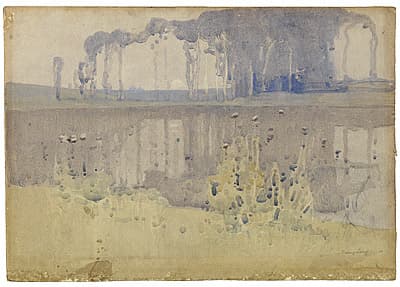Sydney
LONG
Australia
1871
–
London
1955
England, Europe 1910-21; Australia 1921- 22; England 1922-25; Australia 1925-52; England from 1952
23.3 (h) x 33.6 (w) cm
signed ‘Sydney Long’ lower right Queensland Art Gallery, Brisbane, bequest of George Brown 1977
This delicately beautiful watercolour was most likely painted during the first decade of the 20th century, a period during which Long had settled into a decorative, aestheticised approach to the Australian landscape.
Long could be a meticulous draughtsman – as his substantial catalogue of etchings would later demonstrate – but, here in watercolour, his loose technique takes on an abstract quality. Verity slips away into an indefinite space, where light washes bring pigment, paper and image into shared importance; the work is as much an exploration of the medium as representation. Something of the expansiveness of space in Long’s watercolours was perhaps influential on the younger J.J. Hilder.
The clearest elements of the decorative scheme in this watercolour are those farthest away – Long’s signature frieze of sinuous, Art Nouveau trees, standing silhouetted against the horizon and the rising moon, which are then doubled in reflection. We suppose they are gum trees by their ribboned shapes, but they are purposefully stylised. The equally indistinct riparian foliage on the closer side of the riverbank extends elegant droplets of pigment across the water.
Water, reflections and riverbanks recur frequently in Long’s works. These fluvial contemplations mirror an interest in liminal states and that magical time of day – twilight. Here, Long’s European-inflected delicate aestheticism is applied to an Australian mythology of the nocturne, and this watercolour embodies his interest in the nuances between night and day, river and land, dreams and reality.
Angela Goddard
This delicately beautiful watercolour was most likely painted during the first decade of the 20th century, a period during which Long had settled into a decorative, aestheticised approach to the Australian landscape.
Long could be a meticulous draughtsman – as his substantial catalogue of etchings would later demonstrate – but, here in watercolour, his loose technique takes on an abstract quality. Verity slips away into an indefinite space, where light washes bring pigment, paper and image into shared importance; the work is as much an exploration of the medium as representation. Something of the expansiveness of space in Long’s watercolours was perhaps influential on the younger J.J. Hilder.
The clearest elements of the decorative scheme in this watercolour are those farthest away – Long’s signature frieze of sinuous, Art Nouveau trees, standing silhouetted against the horizon and the rising moon, which are then doubled in reflection. We suppose they are gum trees by their ribboned shapes, but they are purposefully stylised. The equally indistinct riparian foliage on the closer side of the riverbank extends elegant droplets of pigment across the water.
Water, reflections and riverbanks recur frequently in Long’s works. These fluvial contemplations mirror an interest in liminal states and that magical time of day – twilight. Here, Long’s European-inflected delicate aestheticism is applied to an Australian mythology of the nocturne, and this watercolour embodies his interest in the nuances between night and day, river and land, dreams and reality.
Angela Goddard
This delicately beautiful watercolour was most likely painted during the first decade of the 20th century, a period during which Long had settled into a decorative, aestheticised approach to the Australian landscape.
Long could be a meticulous draughtsman – as his substantial catalogue of etchings would later demonstrate – but, here in watercolour, his loose technique takes on an abstract quality. Verity slips away into an indefinite space, where light washes bring pigment, paper and image into shared importance; the work is as much an exploration of the medium as representation. Something of the expansiveness of space in Long’s watercolours was perhaps influential on the younger J.J. Hilder.
The clearest elements of the decorative scheme in this watercolour are those farthest away – Long’s signature frieze of sinuous, Art Nouveau trees, standing silhouetted against the horizon and the rising moon, which are then doubled in reflection. We suppose they are gum trees by their ribboned shapes, but they are purposefully stylised. The equally indistinct riparian foliage on the closer side of the riverbank extends elegant droplets of pigment across the water.
Water, reflections and riverbanks recur frequently in Long’s works. These fluvial contemplations mirror an interest in liminal states and that magical time of day – twilight. Here, Long’s European-inflected delicate aestheticism is applied to an Australian mythology of the nocturne, and this watercolour embodies his interest in the nuances between night and day, river and land, dreams and reality.
Angela Goddard

